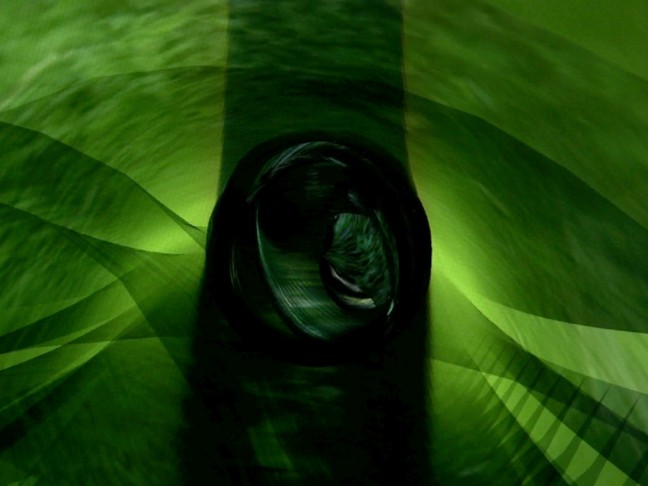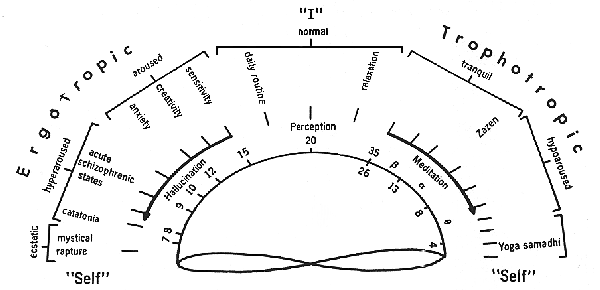Xenolinguistics: the scientific study of languages of non-human intelligences. Publications in this field tend to be speculative as few people have made the claim to have understood an alien language, at least not reliably.
—Wikuniversity
Hallucinations as Alien Art
The key to this discussion is a conceit of the extraordinary vision-producing ability unleashed in consciousness by psychedelics, as alien art: aesthetic productions of an unknown, hence alien, source. Whether the alien is an unknown (normally unconscious) aspect of the Self, an Other, or a blended configuration of Self and Other, can be held in abeyance as part of the high strangeness of the experience. Alien art is construed as an epistemological strategy of the Other in the psychedelic sphere for knowledge acquisition and transmission.

LiveGlide still image, 3D writing.
This view is in sharp contrast to the notion of hallucinations as mechanically generated “form constants,” abstract geometries with no semantic dimension per se. ((Kluver, Heinrich. Mescal and Mechanisms of Hallucinations. Chicago: University of Chicago Press, 1969.)) It is closer to the narrative and highly significant (for the experiencing individual) 1st person reports in Benny Shanon’s ayahuasca phenomenology. ((Shanon, Benny. The Antipodes of the Mind: Charting the Phenomenology of the Ayahuasca Experience. Oxford: Oxford University Press, 2002.)) These aspects of alien art describe features of the visual field that can simultaneously involve cognitive processes accompanied by vivid feeling states; bodily sensations (or lack thereof); and the synaesthetic involvement of other senses.
Benny Shanon, cognitive psychologist and ayahuasca researcher.
Alien art begins with conditions of extended perception, an ascending scale of effects from the sensory amplifications of cannabis and hashish through the full-scale wraparound realities of high-dose sessions of DMT, psilocybin mushrooms, and LSD. These visionary states and content are frequently experienced as going beyond the pleasures of “great visuals” or “psychedelic eye-candy” to their rhetorical and noetic function, with aesthetics and visual languages employed to deliver a teaching, an insight, a revelation or prophecy, or the sought answer to a problem. It is this signifying and hence, in the most basic sense, linguistic aspect of the psychedelic experience that I am calling Xenolinguistics.
The Alien Dimension in Psychedelic Experience
The mythologem of the alien encounter—UFOs; abduction scenarios; prophetic channelings; generations of Star Trek; and cult religions such as Heaven’s Gate and the Raelian dispensation—have haunted the cultural fringe since the mid-20th century brought the first sightings of lights in the sky.

These realtime ingressions of alien novelty were preceded by decades of science fiction speculations. Xenolinguistics—the search for, creation and study of alien languages—has strong connections to science fiction and fantasy, and to the activity of constructing languages, represented by a small but highly communicative sub-culture of “con-langers.” Xenolinguistics connects to the scientifically framed S.E.T.I. discourse on interstellar messaging, ((S.E.T.I.)) and appears as a theme in the literature of psychedelic self-exploration, particularly in the work of Terence and Dennis McKenna. ((McKenna, Terence and Dennis McKenna. The Invisible Landscape: Mind, Hallucinogens, and the I Ching. San Francisco: HarperCollinsSanFrancisco, 1993.)) John Lilly’s work in interspecies communication with dolphins led to his inclusion in the first S.E.T.I. meeting about interstellar messaging and the search for intelligent life in the cosmos. Lilly went further with his researches by combining his technology of sensory isolation tanks with the technology of psychedelic psychopharmacology. Both his methods and his findings placed him outside the pale of institutionally approved science, especially as he reported extensive communication with extraterrestrial intelligence via the Earth Coincidence Control Center (E.C.C.O.) and described new forms of linguistic activity in the psychedelic sphere. ((Lilly, John. The Center of the Cyclone: An Autobiography of Inner Space. New York: Bantam Books, 1979.)) Another major outlaw scientist of the psychedelic sphere, Timothy Leary, received his own extraterrestrial download, The Starseed Transmission, while in solitary confinement in Folsom Prison.
The psychedelic sphere is reported by practicing shamans, mainstream and outlaw scientists, and psychedelic self-explorers to be populated by communicating entities. Horace Beach’s 1996 dissertation, “Listening for the Logos: A Study of Reports of Audible Voices at High Doses of Psilocybin,” ((Beach, Horace. “Listening for the Logos: A Study of Reports of Audible Voices at High Doses of Psilocybin.” Ph.D. dissertation, California School of Professional Psychology, Alameda, California, 1996.)) finds that of a sample of 128 participants (with experience with psilocybin), better than a third experienced communications with a perceived voice. The DMT (dimethyltriptamine) archives at the Vaults of Erowid, ((Erowid.org)) a database of psychedelic information, have many reports of encounters with entities while in the tryptamine trance, some of which include reports of alien language. ((www.erowid.org/experiences/exp.php?ID=1859)) The literature of shamanism contains pantheons of helpful and malign spirits, guides, allies, gods and demons, angels, extraterrestrials, and ancestors. ((Shanon, 2002.)), (( Polari de Alverga, Alex. Forest of Visions: Ayahuasca, Amazonian Spirituality, and the Santo Daime Tradition. Rochester, Vermont: Park Street Press, 1999.)) Within these persistent experiences of encounters with entities can be found reports of new forms of language deployed in these contacts with the Other, and a complex of related notions about language, consciousness, and reality. There is an aspect of each of these perspectives on alien language in my own work: a fictional, constructed language within a story world; the S.E.T.I. discourse; and contact and communication with the Other in psychedelic self-exploration. I will focus on the role of psychedelic self-exploration which resulted in the creation and explication of an alien language, Glide, through a novel The Maze Game, ((Slattery, Diana Reed. The Maze Game. Kingston: Deep Listening Publications, 2003.)) academic research, and the development of interactive software as writing instruments for this visual language. ((www.academy.rpi.edu/glide))
Psychedelic Science
Psychedelic Science incorporates many disciplines in its search for understanding of human experience with these mind-altering substances, a history that appears to go back to the earliest signs of culture in cave paintings and remains in Europe and Africa. ((Nichols, David E. “Hallucinogens,” Pharmacology & Therapeutics 101 (2004) 131—181.)) Neuroscience, physiology, microbiology, biochemistry, paleo-anthropology, ethnobotany, philosophy, rhetoric, and consciousness studies all play a role. It may seem obvious that first person reports are necessary to communicate the experiences and provide matching data to whatever third person observations (physiological signs, neurological imaging of brain activity, chemical structure-activity analyses) are made. However, the treatment of subjectivity within consciousness studies is contested ground. ((Wallace, Alan B. The Taboo of Subjectivity: Toward a New Science of Consciousness. New York: Oxford University Press, 2000.))
Consciousness itself had been operationally disbarred from scientific discourse in the early 20th century as psychology turned to behaviorist models ((Baars, Bernard J. In the Theater of Consciousness: The Workspace of the Mind. Oxford: Oxford University Press, 1997.)) and empirical methods, excluding all forms of subjective introspectionism. Psychophysics, with its experimental designs, accepted subjective reports about clearly defined bits of perception, memory, and cognition as reliable enough to produce repeatable experiments, verifiable and useful generalities and even laws. Characterizing the nature of the Self, the I that deems itself conscious and reflects on the content and operations of consciousness, is dependent on one’s epistemological biases. The concept of Self is inextricably connected to the concept of the Other; the dichotomy of subjective and objective; observer and observed; and, following James, the knower and the known. In consciousness studies, Self and Other are assumed as stable, if not universal, categories; ((Baars, 1997.)) the discussion and use of first and third person methods in the study of consciousness assumes this structural stability. Within consciousness studies, the material reductionist position, held by Dennett, Churchland, and Hardcastle, treats mind (including Self-concept) as an epiphenomenon of matter. ((Shear, Jonathan, ed. Explaining Consciousness—the Hard Problem. Cambridge: The MIT Press, 1998.)) Mind and subjectivity are defined, if not out of existence, certainly to a non-fundamental status. These issues become even more problematic in psychedelic mindbody states, as the experience of the differentiation between Self and Other is radically re-organized in ways ranging from a mystical merging into Oneness through a plethora of encounters and relations: teaching and guidance; erotic interchange; adversarial struggles; many forms of paradoxical both-and relations, and group mind experiences which have no parallel in ordinary reality.
Reality is a critical concept in psychedelic science. The ontological status of experiences in the psychedelic sphere is inevitably called into question, both from within firsthand experience, and when these reported experiences are interpreted by others who may or may not have had similar experiences. A high degree of novelty, and the bizarre (from a baseline perspective) qualities of what can be seen, heard, and felt, sometimes deeply and profoundly, can be experienced in altered states. It is this “high strangeness” that provides the opening for labeling the experiences themselves “unreal,” and therefore unworthy of serious study, or merely symptoms of mental disorder. I have written on this topic elsewhere, characterizing psychedelic science as “the discourse of the unmentionable by the disreputable about the unspeakable.” ((These observations can be accessed by the following method, outlined by Terence McKenna. Ingest 4—5 grams dried psilocybe mushrooms alone in silent darkness, in a setting that is safe and free from interruption. Note: This protocol is not an invitation to perform illegal acts. There are places on the planet where such an experiment can be carried out legally. For up-to-date information, go to Erowid.))

Reality and perception are tightly coupled, as Roland Fischer’s model of the perception—hallucination continuum depicts. ((Fischer, Roland. “A Cartography of the Ecstatic and Meditative States.” Science, Vol. 174, Num. 4012, 26 November 1971.)) In simplest terms, when perception changes, what we construe to be reality changes.
Charles Tart built models of levels or states of consciousness, and called for the introduction of state-specific sciences, and the possibility of state-specific language to adequately deal with the different realities perceived in altered states. ((Tart, Charles T. “States of Consciousness and State-Specific Sciences.” Science, Vol. 176, 1203—1210, 1972.))
John Lilly’s protocols reflect the problem from a methodological standpoint:
In a scientific exploration of any of the inner realities, I follow the following metaprogrammatic steps:
1. Examine whatever one can of where the new spaces are, what the basic beliefs are to go there.
2. Take on the basic beliefs of that new area as if true.
3. Go into the area fully aware, in high energy, storing everything, no matter how neutral, how ecstatic, or how painful the experiences become.
4. Come back here, to our best of consensus realities, temporarily shedding those basic beliefs of the new area and taking on those of the investigator impartially dispassionately objectively examining the recorded experiences and data.
5. Test one’s current models of this consensus reality.
6. Construct a model that includes this reality and this new one in a more inclusive succinct way. No matter how painful such revisions of the models are be sure they include both realities.
7. Do not worship, revere, or be afraid of any person, group, space, or reality. An investigator, an explorer, has no room for such baggage. ((Lilly, John. The Deep Self. New York: Warner Books, 1977.))
When one is engaging communication with the Other in the psychedelic sphere, it pays to have protocols. Lilly’s protocol privileges neither the ordinary nor the non-ordinary states of consciousness, but attempts to include both in the construction of a new model of reality of multiple mind-states and multiple realities. Terence McKenna and Lilly both recommend never giving up one’s skeptical stance. McKenna is also clear on the necessity of reporting the subjective content. When describing the structure-activity of a psychedelic substance, the language of biochemistry reveals none of the high strangeness of the experiences. Describing the content of a visionary state—the images, environments, novel space-time configurations, denizens, languages, and information acquired in the experience—is often much less palatable to the scientific world-view.
My approach is simply this: to take the phenomenological position of saying what was personally seen and experienced as accurately as possible, not editing out information just because it strains credulity, or demands continual repair to my worldview, or that of my readers. Part of the phenomenological epoche or bracketing in this effort consists in setting aside the drive to determine the ontological status of the experiences, especially since abstractions such as “reality” can themselves be radically re-configured in the psychedelic sphere. Further, I examine the reports of others, however unsettling, with the same good faith, engaging in a comparison of texts, essentially a literary and rhetorical activity, with no claims made as to the “reality”, in baseline terms, of the findings. The correlations among texts provide sufficient intrasubjective validation to indicate the possibility that the authors of the reports have spent time in realities sufficiently similar to establish, not a consensus—there are far too few in-depth reports gathered over multiple sessions—but perhaps a set of recognizable landmarks that can form the first sketches of maps of a “reality” that includes these experiences. This may seem an epistemologically primitive method, when compared to the scientific paradigm, yielding no proofs, no reliably repeatable experiments, and few samples to examine. Yet, as David Turnbull argues, “scientific knowledge can be seen as “the contingent assemblage of local knowledge.” I suggest it is a starting place toward subjective (personal, first person, individual) psychedelic knowledge, building a collection of what David Turnbull terms “local knowledges.” These localities can be as particular as a single individual’s three-paragraph trip report posted to Erowid; as extensive as a single individual’s lifework; or as comprehensive as the collective practices and knowledge of a culture, such as the Mazatec mushroom culture, the Peyote Way, or an ayahuasca culture, such as Santo Daime, União de Vegetal, or Barquinha. Each locality, from the individual to the group produces its own accounts of experience in the psychedelic sphere, its own descriptions of the landscapes, its own sense of the intentionality of the voyage from baseline outwards/inwards and return to ordinary reality. From these experiences descriptions are written, interpretations arise, songs, paintings, software, and dances emanate; rituals are enacted. A body of knowledge collects. Maps can be envisioned, landmark by negotiated landmark.
Source: psychedelicsandlanguage.com


Validate your login
Sign In
Create New Account